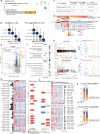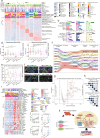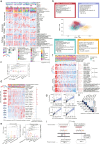Integrated proteogenomic characterization across major histological types of pituitary neuroendocrine tumors
- PMID: 36307579
- PMCID: PMC9715725
- DOI: 10.1038/s41422-022-00736-5
Integrated proteogenomic characterization across major histological types of pituitary neuroendocrine tumors
Abstract
Pituitary neuroendocrine tumor (PitNET) is one of the most common intracranial tumors. Due to its extensive tumor heterogeneity and the lack of high-quality tissues for biomarker discovery, the causative molecular mechanisms are far from being fully defined. Therefore, more studies are needed to improve the current clinicopathological classification system, and advanced treatment strategies such as targeted therapy and immunotherapy are yet to be explored. Here, we performed the largest integrative genomics, transcriptomics, proteomics, and phosphoproteomics analysis reported to date for a cohort of 200 PitNET patients. Genomics data indicate that GNAS copy number gain can serve as a reliable diagnostic marker for hyperproliferation of the PIT1 lineage. Proteomics-based classification of PitNETs identified 7 clusters, among which, tumors overexpressing epithelial-mesenchymal transition (EMT) markers clustered into a more invasive subgroup. Further analysis identified potential therapeutic targets, including CDK6, TWIST1, EGFR, and VEGFR2, for different clusters. Immune subtyping to explore the potential for application of immunotherapy in PitNET identified an association between alterations in the JAK1-STAT1-PDL1 axis and immune exhaustion, and between changes in the JAK3-STAT6-FOS/JUN axis and immune infiltration. These identified molecular markers and alternations in various clusters/subtypes were further confirmed in an independent cohort of 750 PitNET patients. This proteogenomic analysis across traditional histological boundaries improves our current understanding of PitNET pathophysiology and suggests novel therapeutic targets and strategies.
© 2022. The Author(s).
Conflict of interest statement
The authors declare no competing interests.
Figures






Comment in
-
Pituitary adenomas: new insights, new therapeutic targets.Cell Res. 2023 Jan;33(1):3-4. doi: 10.1038/s41422-022-00758-z. Cell Res. 2023. PMID: 36588122 Free PMC article. No abstract available.
Similar articles
-
Molecular characterization of epithelial-mesenchymal transition and medical treatment related-genes in non-functioning pituitary neuroendocrine tumors.Front Endocrinol (Lausanne). 2023 Mar 22;14:1129213. doi: 10.3389/fendo.2023.1129213. eCollection 2023. Front Endocrinol (Lausanne). 2023. PMID: 37033229 Free PMC article.
-
Pituitary neuroendocrine tumors with PIT1/SF1 co-expression show distinct clinicopathological and molecular features.Acta Neuropathol. 2024 Jan 16;147(1):16. doi: 10.1007/s00401-024-02686-1. Acta Neuropathol. 2024. PMID: 38228887 Free PMC article.
-
Overview of the 2022 WHO Classification of Pituitary Tumors.Endocr Pathol. 2022 Mar;33(1):6-26. doi: 10.1007/s12022-022-09703-7. Epub 2022 Mar 15. Endocr Pathol. 2022. PMID: 35291028 Review.
-
Annotation of pituitary neuroendocrine tumors with genome-wide expression analysis.Acta Neuropathol Commun. 2021 Nov 10;9(1):181. doi: 10.1186/s40478-021-01284-6. Acta Neuropathol Commun. 2021. PMID: 34758873 Free PMC article.
-
Pituitary Tumors: Genetic and Molecular Factors Underlying Pathogenesis and Clinical Behavior.Neuroendocrinology. 2022;112(1):15-33. doi: 10.1159/000514862. Epub 2021 Feb 1. Neuroendocrinology. 2022. PMID: 33524974 Review.
Cited by
-
Comprehensive mapping of somatotroph pituitary neuroendocrine tumour heterogeneity using spatial and single-cell transcriptomics.Clin Transl Med. 2024 Nov;14(11):e70090. doi: 10.1002/ctm2.70090. Clin Transl Med. 2024. PMID: 39548559 Free PMC article.
-
Unlocking the Genetic Secrets of Acromegaly: Exploring the Role of Genetics in a Rare Disorder.Curr Issues Mol Biol. 2024 Aug 20;46(8):9093-9121. doi: 10.3390/cimb46080538. Curr Issues Mol Biol. 2024. PMID: 39194755 Free PMC article. Review.
-
Integrated plasma and vegetation proteomic characterization of infective endocarditis for early diagnosis and treatment.Nat Commun. 2025 May 30;16(1):5052. doi: 10.1038/s41467-025-60184-8. Nat Commun. 2025. PMID: 40447567 Free PMC article.
-
Single-cell and spatial transcriptome analyses reveal tumor heterogeneity and immune remodeling involved in pituitary neuroendocrine tumor progression.Nat Commun. 2025 May 30;16(1):5007. doi: 10.1038/s41467-025-60028-5. Nat Commun. 2025. PMID: 40442104 Free PMC article.
-
Molecular feature-based classification of retroperitoneal liposarcoma: a prospective cohort study.Elife. 2025 May 23;14:RP100887. doi: 10.7554/eLife.100887. Elife. 2025. PMID: 40407808 Free PMC article.
References
Publication types
MeSH terms
LinkOut - more resources
Full Text Sources
Medical
Research Materials
Miscellaneous

